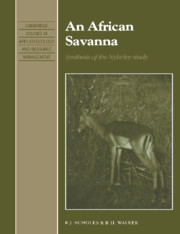Book contents
- Frontmatter
- Contents
- Preface
- I Nylsvley in an African savanna context
- 1 African savannas: an overview
- 2 The people of Nylsvley
- 3 The climate at Nylsvley
- 4 Geology, landform and soils
- 5 The Nylsvley biota
- II The key determinants: water, nutrients, fire and herbivory
- III The carbon cycle
- IV Community and landscape pattern and change
- Part V Lessons from Nylsvley
- Bibliography
- Index
4 - Geology, landform and soils
Published online by Cambridge University Press: 06 October 2009
- Frontmatter
- Contents
- Preface
- I Nylsvley in an African savanna context
- 1 African savannas: an overview
- 2 The people of Nylsvley
- 3 The climate at Nylsvley
- 4 Geology, landform and soils
- 5 The Nylsvley biota
- II The key determinants: water, nutrients, fire and herbivory
- III The carbon cycle
- IV Community and landscape pattern and change
- Part V Lessons from Nylsvley
- Bibliography
- Index
Summary
On a global scale, the distribution of savannas is determined by climate. Within this area of broad distribution, however, the occurrence and type of savanna at any given point are mostly determined by soil conditions. The influence of soil is especially clear in African savannas because of the range of weathering states that is represented. In recent landscapes, such as the glaciated regions of the northern hemisphere, all the soils tend to be fertile and of similar texture, since the soil-forming processes have not had time to differentiate them. At the other extreme, the soils of very old or intensively weathered landscapes, such as tropical forests, tend to converge to an infertile and clayey endpoint, irrespective of the original material. In drier stable landscapes, more of the diversity of the parent materials is expressed in the soil. African savannas span a range of rainfall, parent geology and landscape age, and therefore exhibit considerable soil variation. Extremes of fertility and texture occur along with a range of intermediate states.
The soil interacts with plants growing in it through a combination of chemical exchanges and physical effects. Soil chemistry primarily influences plant nutrition, while soil physics plays a crucial role in plant water supply. Since the processes of nutrient mineralisation, transport to the roots and uptake are water-dependent, and dry savannas are by definition water-limited, soil physics is an especially important determinant of dry savanna structure and function.
- Type
- Chapter
- Information
- An African SavannaSynthesis of the Nylsvley Study, pp. 34 - 42Publisher: Cambridge University PressPrint publication year: 1993



